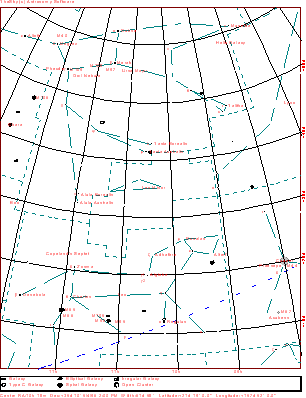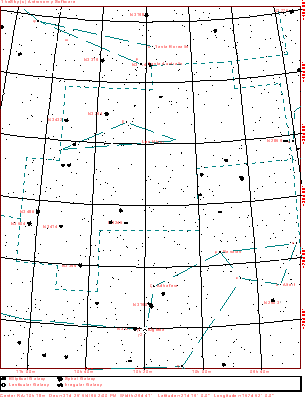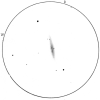
| Home | Deepsky Atlas | TheAstronews | Links | Solar System | ||||||

Hawaiian Astronomical SocietyConstellations: Leo Minor -- Small Lion, Big Feet |
||||||||||

Click the map for a 923x1200 version of the above. Click here for a map better suited for use in the field.

This a more detailed view of the constellation. The map displays stars to magnitude 10, and deepsky objects to magnitude 12. Click here for a map better suited for use in the field.
Image on the left is from the Princeton University Galaxy Catalog. Image on the right is a photograph by Pedro Ré.
|
 12k GIF A description of NGC3432 (Best 66) by Jere Kahanpää, observing with an 8" Newtonian at 126x: A nice edge-on galaxy. A quite bright core surrounded by a very elongated glow, about 7'x1.2'. 3 12-13m stars very near the galaxy: a lone one SE of the brighter parts at the edge and a somewhat fainter pair near the SW tip. The central brightening is broadly mottled. The brightest patch is 1' WNW from the star near the core. Diam. about 15''. 12k GIF A description of NGC3432 (Best 66) by Jere Kahanpää, observing with an 8" Newtonian at 126x: A nice edge-on galaxy. A quite bright core surrounded by a very elongated glow, about 7'x1.2'. 3 12-13m stars very near the galaxy: a lone one SE of the brighter parts at the edge and a somewhat fainter pair near the SW tip. The central brightening is broadly mottled. The brightest patch is 1' WNW from the star near the core. Diam. about 15''.
The drawing is by Jere as well.
|
 33k JPEG NGC3003 (on the right) is one of Dreyer's remarkable objects. It is a spiral galaxy described as quite bright (12.3), large (5.7'x1.7'), and very much elongated (P.A. 90). Others report no nucleus, and a series of dark knots and filamentary arms. 33k JPEG NGC3003 (on the right) is one of Dreyer's remarkable objects. It is a spiral galaxy described as quite bright (12.3), large (5.7'x1.7'), and very much elongated (P.A. 90). Others report no nucleus, and a series of dark knots and filamentary arms.
The other "bright" galaxy on the left is NGC3021. Dreyer calls it fairly bright, fairly small, very little elongated, with a much brighter middle. The star just to the SE is mag. 10. NGC3021 lies 31' ENE of NGC3003.
NGC3013 lies between the other two galaxies, just 2.7' SE of the bright (mag. 7.8) star SAO61706. Dreyer describes this galaxy as fairly faint (mag.15), fairly small, round, with a bright middle. Image from the Digital Sky Survey.
|
If you have any questions about the Hawaiian Astronomical Society
please
(link requires javascript).